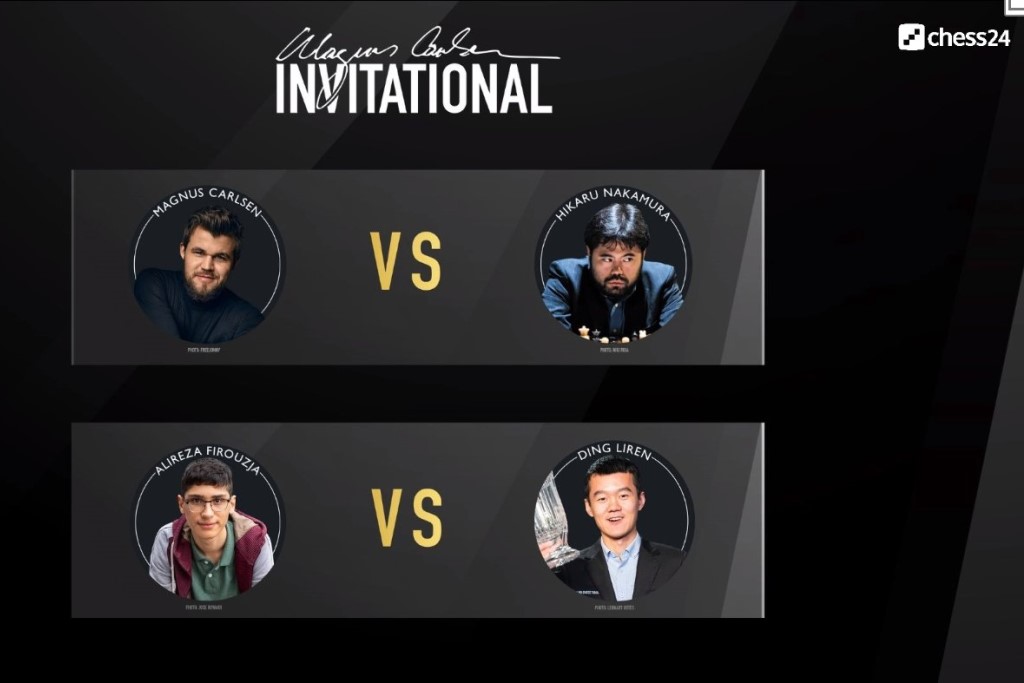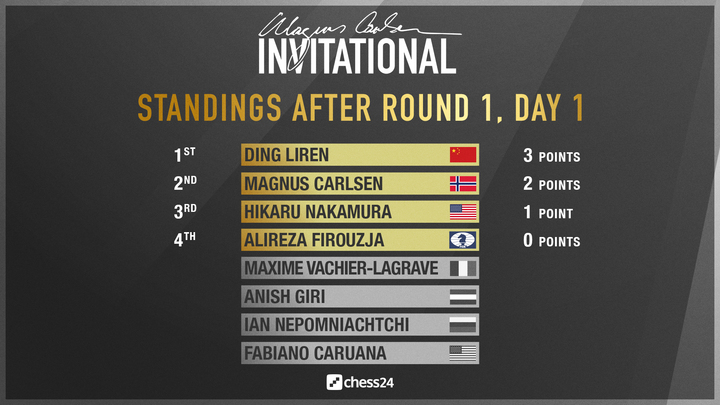


The first online non-blitz super-tournament started with a bang, as five out of eight rapid games ended decisively and one of the draws of the day was perhaps the most exciting encounter. Given Carlsen's extremely high standards even in accelerated time controls, his play seemed a little below average. In the end, he and Nakamura won both their rapid games with the white pieces. The world champ chose the black pieces in the Armageddon decider and ended up winning both that game and the match.
A strange situation was seen during the sudden-death decider, as Nakamura seemed to be talking to the camera. The commentators thought he was streaming his game, when in fact he was reacting to the fact that an arbiter sent him a text message while he was considering his 25th move.
The problem was that the clocks shown via live-streaming — and apparently what the arbiters were seeing — had displayed Carlsen having more than 4 minutes, the time allocated for Black in the Armageddon. The players' clocks were correctly set up though. Nakamura was visibly disturbed, but did not make a fuss of it, quickly posting on his Twitter account:
Fun match, very unsatisfactory ending with the arbiter writing a message to me in the middle of the game to abort while I am thinking about playing Kf1 or Kh1! Not that it changes the outcome, but still...
— Hikaru Nakamura (@GMHikaru) April 18, 2020
Other than that, the technical side of the first-ever super-tournament played online worked fine, so we do not expect this to happen again.
In both of his games with white, the world champion employed a QGD system with Bf4, closing the structure on the queenside early in the game. The first time around he got a clean positional victory, while game three saw Nakamura mishandling a four-knight endgame.
Meanwhile, when Nakamura was playing white, things got a little wilder. In game two, he built up a strong kingside attack, which allowed him to show a flashy combination:
The American star played 30.gxf6, when Black cannot capture the queen with 30...fxg3 due to 31.gxf7+ Kh8 and both 32.fxe8Q+ or 32.f8Q+ win. Carlsen was not completely lost, but he fell under pressure and ended up allowing his opponent to give mate on move 40.
In the last rapid game of the match, Carlsen surprisingly chose a double-edged with black while needing only a draw. Then, he got a superior position, which he spoiled on move 17:
Carlsen's 17...Bxe5 gave way to 18.Bxf7+ Kh8 19.Bxe8. And here the Norwegian faltered again, playing 19...Qb6+ instead of the natural-looking 19...Bxf1. The queens soon left the board, and White was in the driver's seat. Nakamura showed good technique to convert his advantage.
The colour distribution for the Armageddon is decided by a drawing of lots. Carlsen got to choose and opted for the black pieces. He won the game despite only needing a draw.
Select an entry from the list to switch between games
After a well-played draw, two of the strongest contenders to challenge Carlsen for the World Championship crown — one at the moment, the other in the long run — played a thrilling double-edged game. Kings were castled on opposite sides and it was not clear who had the quicker attack. Firouzja, playing white, had the more vulnerable monarch though, and a single miss left him in a difficult position:
The 16-year-old wunderkind defended the attacked rook with 33.Rhc1, missing 33...Bxa3 — White cannot capture with 34.Rxa3 due to 34...Rb8+, when the only way to defend against the mate on b2 is by giving up tons of material. Ding had a winning advantage and showed good tactical skills to convert it into a win eleven moves later.
Ding had white in game three, and quickly gained the upper hand against his rival's aggressive attempts. By move 30, White had a large edge:
The Chinese's 30.Bd3 is a fine consolidating move that keeps things under control, but 30.Qc1 with the idea of transferring the queen to h6 was a very strong alternative. White's desire to avoid any trouble gave Black chances to equalize and the game ended up drawn after 42 moves.
Ding could have secured match victory with a win, but did not allow this setback to trouble him enough to lose the final game. Firouzja did get some pressure, but in the end could not break his famed opponent's defences.
Select an entry from the list to switch between games

GM Yannick Pelletier recapped day one's action
The Magnus Carlsen Invitational is brought to you by chess24.com. Learn more about the tournament at magnuscarlsen.com/en/invitational